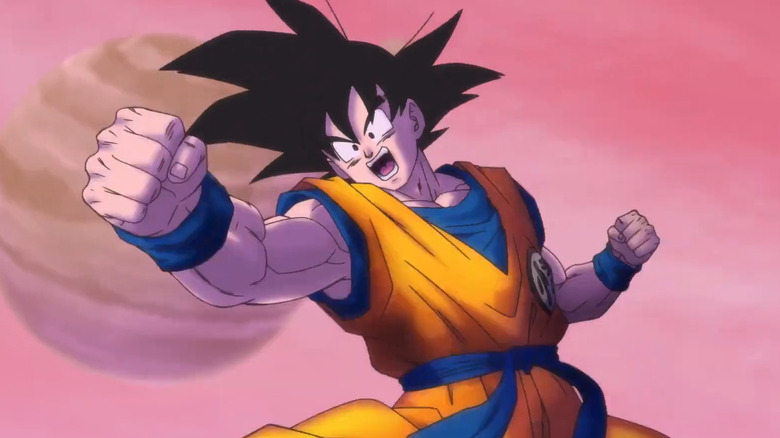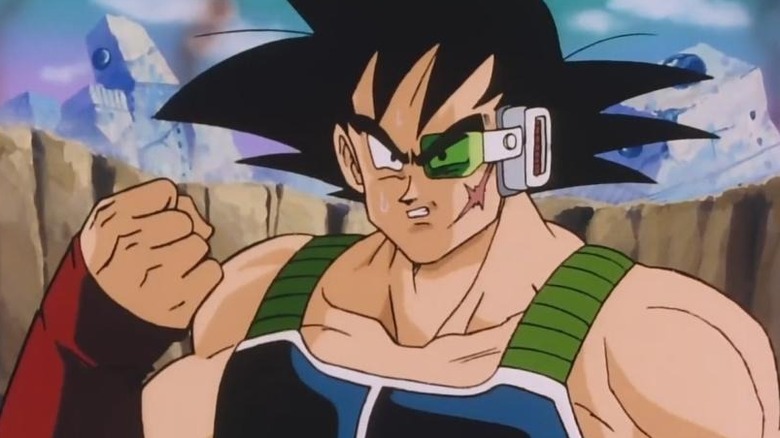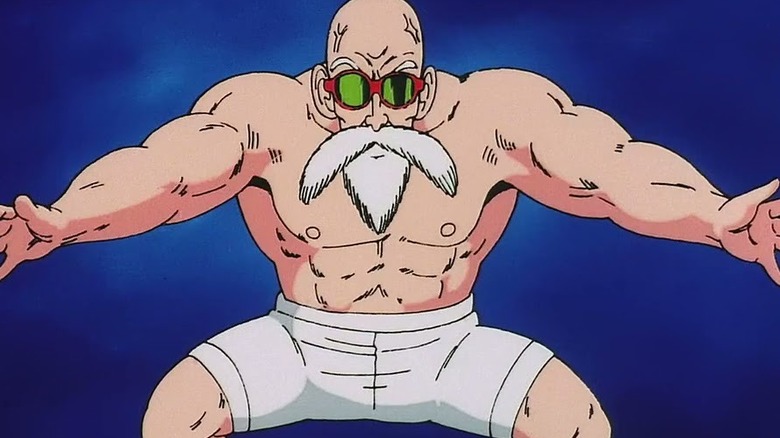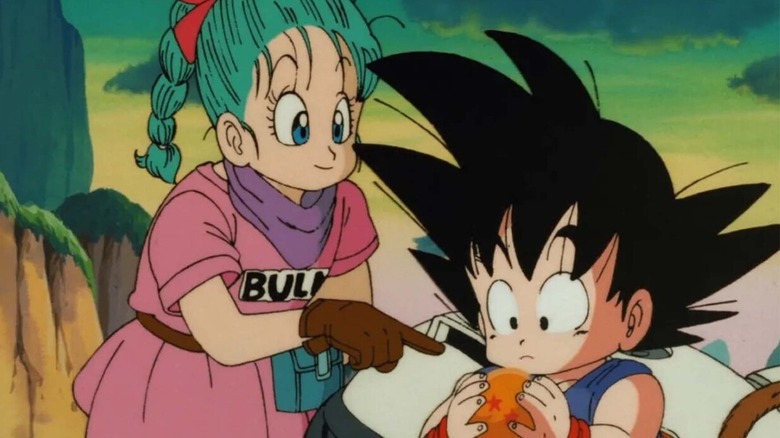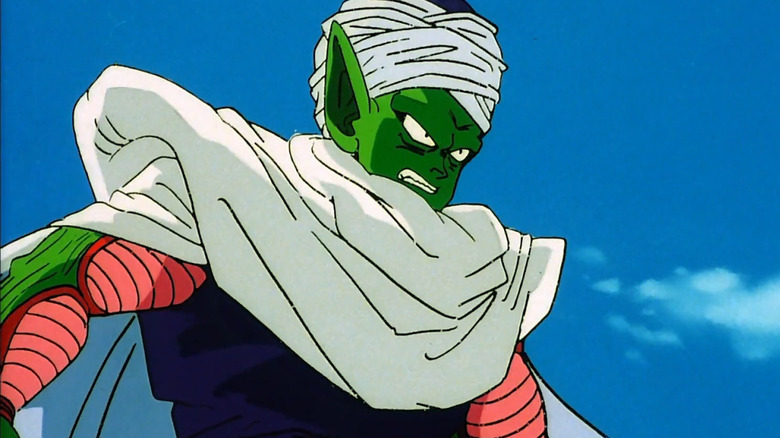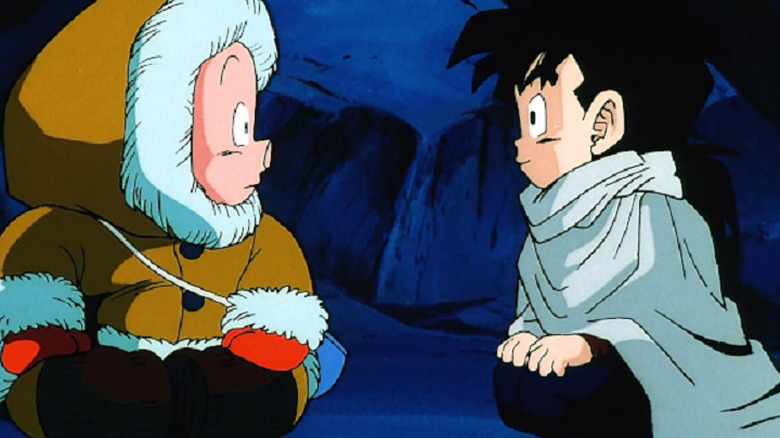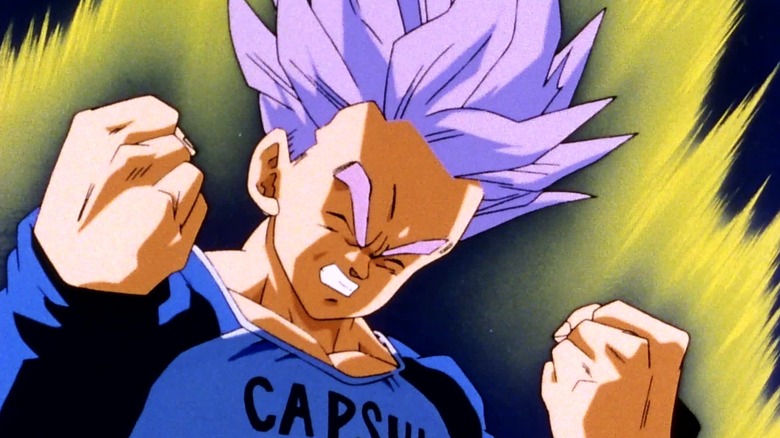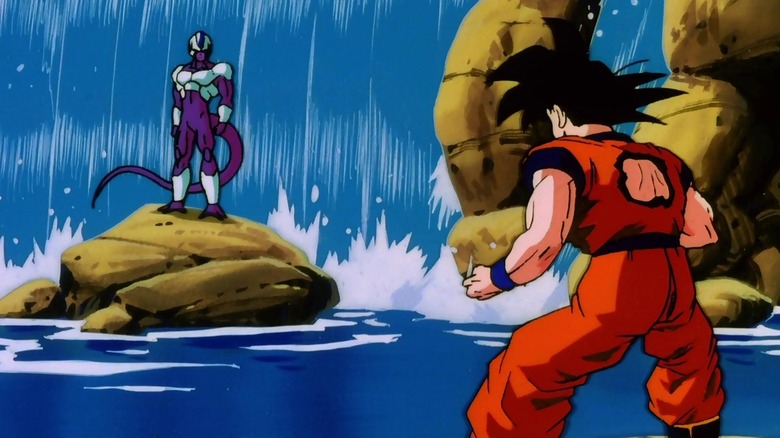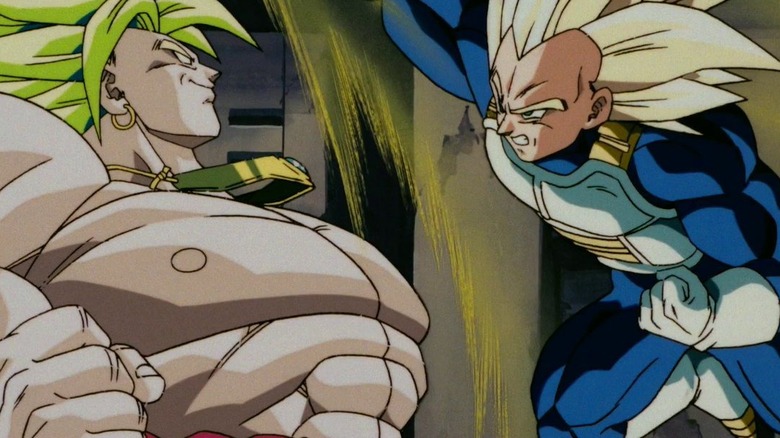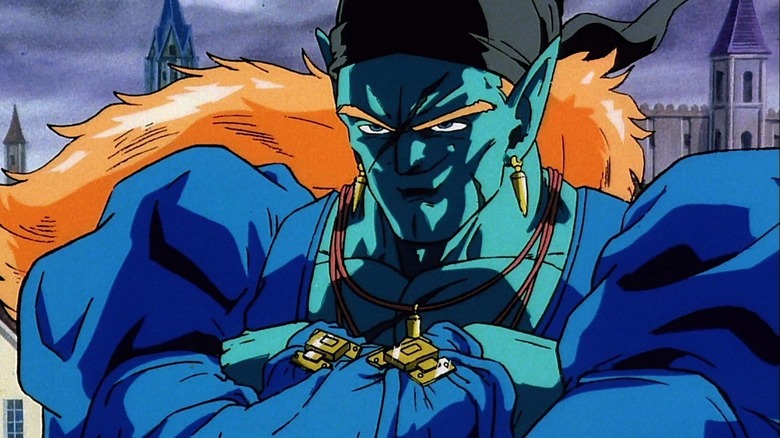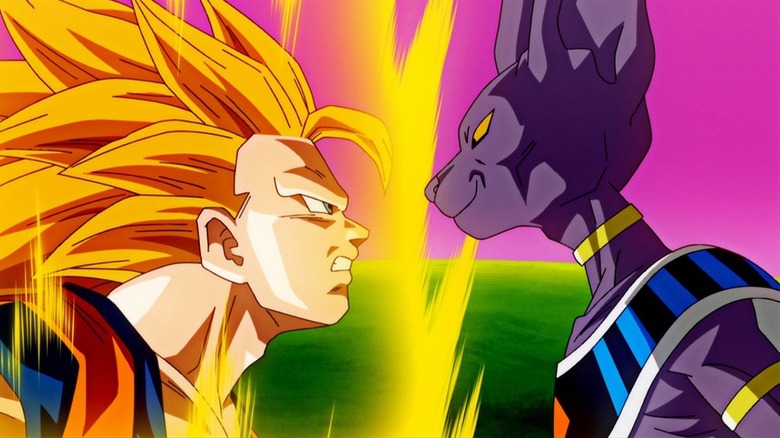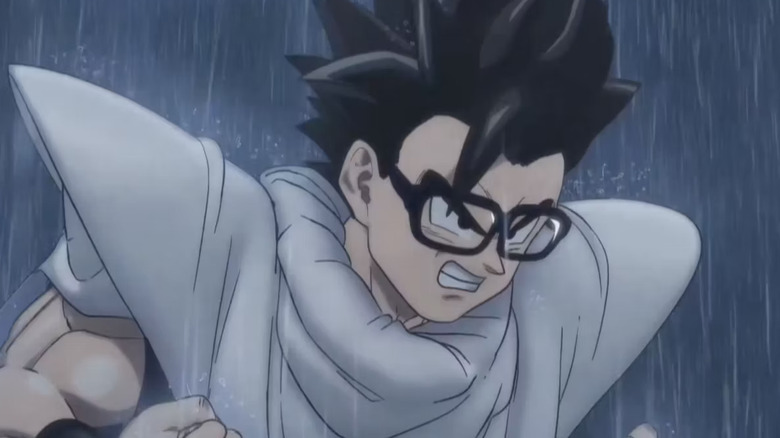The Correct Order In Which To Watch Every Dragon Ball Movie
"Dragon Ball" can feel overwhelming to jump into, as it's been around for close to 40 years and encompasses many different types of media. The best approach for newcomers to fully immerse themselves in the franchise's universe is to watch the "Dragon Ball" TV shows. Luckily, the shows were released in chronological order: "Dragon Ball" leads into "Dragon Ball Z," which leads into "Dragon Ball Super." There's also "Dragon Ball GT," but it's not the most popular "Dragon Ball" series and isn't really canon anyway, so it's definitely skippable.
What about the movies, though? Well, that's where things get really tricky. Most of the movies aren't canon, or they take place in an alternate timeline, or they are a rough retelling of an existing event. But many of them are great, and it's worth your while to watch them, especially as they serve as great supplements to the various series.
You could just watch all the movies in the order they were released, and you would mostly be fine, but there is something to be said for digging a little deeper and watching them in a more compelling order. Here's the order we recommend, and we'll make sure to go very light on plot points so as not to spoil too much if this will be your first journey through the world of "Dragon Ball" movies. Oh, and we'll only be discussing the animated "Dragon Ball" movies – the correct order in which to watch the live-action "Dragon Ball" films is to not watch them.
The prequel to everything
Though it was released in 1990 and is considered a "Dragon Ball Z" film, we would argue that "Dragon Ball Z: Bardock — The Father of Goku" is a great place to start your overall "Dragon Ball" journey. Goku starts the original "Dragon Ball" as a young kid, so a movie that looks back at the origins of his father makes "Bardock" a prequel to the entire franchise.
In fact, for those who are also including the TV series in their "Dragon Ball" deep dive, there's something to be said for watching "Bardock" even before starting the original "Dragon Ball" anime. But it definitely serves as an interesting starting point for the movie series, as it is roughly the oldest point in the primary "Dragon Ball" timeline seen in any of the films. Some fans might argue that there's value in waiting until Bardock is introduced in the regular "Dragon Ball" mythos, but in this case, we say first timers should watch this prequel first if they have the option.
The two origin story movies
Once you've seen the prequel, it's time to move onto the origin story of the "Dragon Ball" universe. But just to make sure things stay nice and confusing, there are actually two "Dragon Ball" origin movies – "Curse of the Blood Rubies" (1986) and "The Path to Power" (1996). The former is the actual first "Dragon Ball" movie ever released, so it's the best choice for following up "Bardock." As is common with the "Dragon Ball" movies, the first meeting between Goku and Bulma is presented differently than how it goes down in the "Dragon Ball" TV series, but it's still a great entry point to their complicated friendship for new fans.
As for "The Path to Power," it's no coincidence that it came out exactly 10 years after "Curse of the Blood Rubies" – it was specifically intended to coincide with both the 10th anniversary of the series, and to cap off the then-recently wrapped "Dragon Ball Z" anime. It tells yet another reimagining of the origins of Goku's quest to find the Dragon Balls and take on the Red Ribbon Army, so it makes a neat double feature with "Curse of the Blood Rubies" in that respect, and it gets the last of the origin-prequel movies knocked out before you can finally move on to the first actual "Dragon Ball" movie sequel in the chronology.
The last two films of the original series
"Sleeping Princess in the Devil's Castle" (1987), the second original "Dragon Ball" movie, brings the audience up to the point where Goku begins his training under Master Roshi, as well as his first meeting with Krillin. Roshi sends the young warriors on their first mission which, not surprisingly, ends up being much more dangerous than previously thought. The movie also sees Roshi preparing Goku and Krillin for their first world tournament.
The final movie to take place within the scope of the original "Dragon Ball" is 1988's "Mystical Adventure." It touches on both the "World Tournament Saga" and the "Red Ribbon Army Saga," and features Goku placing some misplaced trust in Master Shen. Though there is plenty of silliness to be had in "Dragon Ball Z," that series has a more mature and serious tone than OG "Dragon Ball," so it's fitting that the latter is capped off with this relatively light romp of a film before the franchise flashes forward to adulthood.
The prequel to Dragon Ball Z
After a two-year break in the "Dragon Ball" film series, the "Dragon Ball Z" movie era kicks off with 1989's "Dead Zone." Setting up the events of the "Dragon Ball Z" TV series – though impossible to consider fully canon due to various inconsistencies that eventually present themselves in the anime — "Dead Zone" serves as a great introduction to the second generation of the franchise.
As previously mentioned, Goku is not only an adult by this point, but he's got a son named Gohan who immediately figures heavily into the story. To that end, "Dead Zone" sets up a lot of the characters who are going to be major players throughout "Dragon Ball Z." It's a no-brainer for "Dead Zone" to be the first "Dragon Ball Z"-related thing someone watches, whether they are only watching the movies or they plan to then dive into the anime series afterward.
The first Dragon Ball Z movie trilogy
The second "Dragon Ball Z" movie, "The World's Strongest" (1990), assumes its audience has been watching the show and is caught up with the first 40 or so episodes. As such, this is the first "Dragon Ball" movie that might be tricky to follow for those who have only seen the films, as it doesn't work as a standalone story as well as the previous movies. Still, it's possible to jump in fresh and still enjoy the heroes' battle against Dr. Kochin and Dr. Wheelo.
Released the same year, third "Dragon Ball Z" movie "The Tree of Might" is another one that joins an already in-progress storyline and isn't the easiest to jump into without watching the show. But it can be enjoyed on visual spectacle alone — particularly the breathtaking battle between Goku and Turles — even if the finer points of the story will be lost on anyone who isn't at least 50 episodes deep into a "Dragon Ball Z" binge.
Finally, there's 1991's "Lord Slug," which a lot of Western "Dragon Ball" fans have a soft spot for as it was the first movie that uses music from American heavy metal bands in the dubbed version. It's also another great showcase for the action set pieces that the "Dragon Ball" franchise is famous for.
An alternate timeline tale fleshes out Trunks
Before we dive into the next trio of "Dragon Ball Z" movies, let's take a little break and explore the history of Trunks in ... "The History of Trunks" (1993). Because nothing is ever as it seems with "Dragon Ball" – and with "Dragon Ball" movies in particular – this is an alternate-timeline tale that ironically takes place in the future.
The "Dragon Ball" universe is crowded indeed, and for a long stretch of its existence, Goku and Vegeta have hogged most of the spotlight. But of the many "Dragon Ball" characters that never seem to get as much screen time as they deserve, Trunks is definitely high up on that list. So, whether "The History of Trunks" actually happened or not, it's a thrilling adventure full of great action and a wonderful showpiece for a fan-favorite "Dragon Ball" character. Oh, and if you're a fan of progressive metal band Dream Theater, they contributed a handful of songs to the soundtrack of the American dub.
The second trio of Dragon Ball Z films
In an effort to make the "Dragon Ball" movies feel a bit more like standalone experiences, they often have a sort of monster-of-the-week approach where a new villain is introduced and subsequently defeated over the span of a single film. That initially seems to be the case with "Cooler's Revenge" (1991), a movie about Frieza's brother avenging his death. But in a fun and surprising twist, a rare direct "Dragon Ball" movie sequel followed the next year by way of "The Return of Cooler." It's definitely a treat to actually have a story stretch across two "Dragon Ball" movies, something the franchise didn't really do up to this point and has only done infrequently since.
That said, in between the two Cooler-based movies is 1991's "Super Android 13!" – focused on the titular character, along with Android 14 and Android 15 – another rarity in that it outright states that it takes place in a parallel universe rather than just suggesting as much as most "Dragon Ball" movies do. With that in mind, you can watch the two Cooler movies back-to-back and "Super Android 13!" after, or vice versa, but these three films should definitely all be watched together before the next batch of films kicks off a whole new saga for the franchise.
The Broly Saga
Not many "Dragon Ball" characters are important enough to get their own self-titled saga, but Broly earned that distinction across a whopping three films starting with "Broly: The Legendary Super Saiyan" (1993). One of the most powerful villains introduced in the franchise up to that point, Broly doesn't even break a sweat until he's up against the full might of Goku, Vegeta, and more. And speaking of Vegeta, this movie also shows the first glimpse of Planet Vegeta, a seldom seen but no less fascinating aspect of the "Dragon Ball" universe.
Paid off in 1994 with both "Broly – Second Coming" and "Bio-Broly," the "Broly Saga" remains the biggest arc across the entire history of the "Dragon Ball" films, just by virtue of it taking place across three movies. "Bio-Broly" is also special in that it sees Goten be a lead character for the first time in a "Dragon Ball" movie. Spoiler alert: It's not actually the last movie in which Broly is a main character or has his name in the title, but "Bio-Broly" definitely wraps up this particular Broly saga and does so in fine fashion.
Another one-off Dragon Ball Z movie
Though it was released in the midst of the "Broly Saga" films, "Bojack Unbound" (1993) is completely unrelated to those three films, so it's fine to save it for after "Bio-Broly." It's fairly arbitrary whether you watch it before or after the Broly trilogy in terms of chronology, and we mainly placed it after just to break up the various trilogies and not end up with two standalones – this and "Super Android 13!" – back-to-back in the watchlist.
As for the movie itself, "Bojack Unbound" obviously focuses on the character in the title, a member of the evil Hera Clan who has fairly little screen presence outside of this film save for a few video games and a cameo in "Fusion Reborn." But as the focal point for a one-off movie, he's a compelling antagonist, and "Bojack Unbound" a pretty decent ride even if it is fairly low stakes in the grand scheme of things.
The final stretch of Dragon Ball Z films
Before the "Super" era of "Dragon Ball" begins, there's a run of four "Dragon Ball Z" films that stretch that generation into the 2010s – despite the "Dragon Ball Z" anime series wrapping up way back in 1996. The first of the final four is the aforementioned "Fusion Reborn" (1995), which not only features cameos by a number of "DBZ" villains but also marks the debut of the Goku-Vegeta fusion — Gogeta. "Wrath of the Dragon" also came out in 1995 and was the last "Dragon Ball" movie for nearly 20 years.
Though "Wrath of the Dragon" feels more like a setup for "Dragon Ball Super" than it does a finale for "Dragon Ball Z," both 2013's "Battle of Gods" and its 2015 follow-up "Resurrection F" still carry the "Dragon Ball Z" name in their titles, so we're counting them as "DBZ" installments. Not only is this another example of two "Dragon Ball" movies telling one big story, but these two are the first in the history of the franchise to be considered an indisputable part of the main series canon rather than a retelling, side story, or alternate dimension. They were also the first to get a full standalone theatrical release, and they very much look like they have major motion picture budgets for the first time in "Dragon Ball" movie history.
The Dragon Ball Super movies
With confirmation that more "Dragon Ball Super" anime is on the way, it is still considered the "current" generation of the franchise. And on the movie side, there have been two "Dragon Ball Super" movies thus far – "Dragon Ball Super: Broly" (2018) and "Dragon Ball Super: Super Hero" (2022). Like the previous two films, both of the "Dragon Ball Super" movies were theatrical releases and have continued the current trend of "Dragon Ball" movies looking like highly polished, big-budget motion picture events.
As the focus continues to shift away from Goku and more towards Gohan taking over as the primary franchise protagonist, especially in "Super Hero," the latest two films definitely feel like a true passing of the torch for the "Dragon Ball" universe. "Super Hero" in particular features a moment where Gohan does something that no other "Dragon Ball" character has done, not even his father. We won't spoil it — let's just say that you'll have to see it to believe it. Also, make sure you stick around for a fun post-credits moment that longtime "Dragon Ball" fans never thought would happen, and don't be surprised if you find yourself cheering out loud when you see it.
